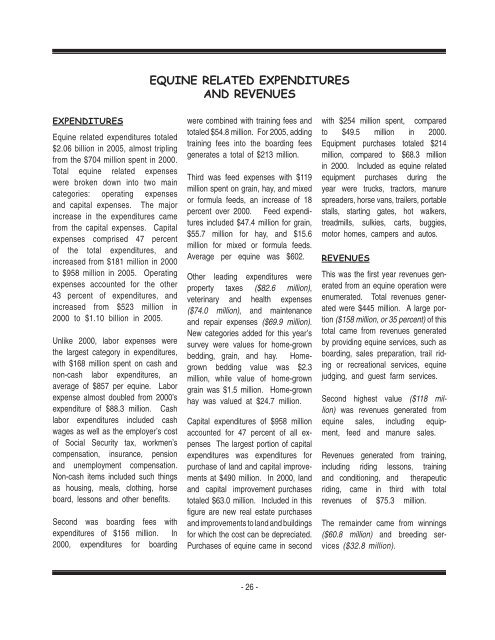Retired Racehorses
tfrr_reportandappendicesfinal
tfrr_reportandappendicesfinal
- No tags were found...
You also want an ePaper? Increase the reach of your titles
YUMPU automatically turns print PDFs into web optimized ePapers that Google loves.
EQUINE RELATED EXPENDITURES<br />
AND REVENUES<br />
EXPENDITURES<br />
Equine related expenditures totaled<br />
$2.06 billion in 2005, almost tripling<br />
from the $704 million spent in 2000.<br />
Total equine related expenses<br />
were broken down into two main<br />
categories: operating expenses<br />
and capital expenses. The major<br />
increase in the expenditures came<br />
from the capital expenses. Capital<br />
expenses comprised 47 percent<br />
of the total expenditures, and<br />
increased from $181 million in 2000<br />
to $958 million in 2005. Operating<br />
expenses accounted for the other<br />
43 percent of expenditures, and<br />
increased from $523 million in<br />
2000 to $1.10 billion in 2005.<br />
Unlike 2000, labor expenses were<br />
the largest category in expenditures,<br />
with $168 million spent on cash and<br />
non-cash labor expenditures, an<br />
average of $857 per equine. Labor<br />
expense almost doubled from 2000’s<br />
expenditure of $88.3 million. Cash<br />
labor expenditures included cash<br />
wages as well as the employer’s cost<br />
of Social Security tax, workmen’s<br />
compensation, insurance, pension<br />
and unemployment compensation.<br />
Non-cash items included such things<br />
as housing, meals, clothing, horse<br />
board, lessons and other benefits.<br />
Second was boarding fees with<br />
expenditures of $156 million. In<br />
2000, expenditures for boarding<br />
were combined with training fees and<br />
totaled $54.8 million. For 2005, adding<br />
training fees into the boarding fees<br />
generates a total of $213 million.<br />
Third was feed expenses with $119<br />
million spent on grain, hay, and mixed<br />
or formula feeds, an increase of 18<br />
percent over 2000. Feed expenditures<br />
included $47.4 million for grain,<br />
$55.7 million for hay, and $15.6<br />
million for mixed or formula feeds.<br />
Average per equine was $602.<br />
Other leading expenditures were<br />
property taxes ($82.6 million),<br />
veterinary and health expenses<br />
($74.0 million), and maintenance<br />
and repair expenses ($69.9 million).<br />
New categories added for this year’s<br />
survey were values for home-grown<br />
bedding, grain, and hay. Homegrown<br />
bedding value was $2.3<br />
million, while value of home-grown<br />
grain was $1.5 million. Home-grown<br />
hay was valued at $24.7 million.<br />
Capital expenditures of $958 million<br />
accounted for 47 percent of all expenses<br />
The largest portion of capital<br />
expenditures was expenditures for<br />
purchase of land and capital improvements<br />
at $490 million. In 2000, land<br />
and capital improvement purchases<br />
totaled $63.0 million. Included in this<br />
figure are new real estate purchases<br />
and improvements to land and buildings<br />
for which the cost can be depreciated.<br />
Purchases of equine came in second<br />
with $254 million spent, compared<br />
to $49.5 million in 2000.<br />
Equipment purchases totaled $214<br />
million, compared to $68.3 million<br />
in 2000. Included as equine related<br />
equipment purchases during the<br />
year were trucks, tractors, manure<br />
spreaders, horse vans, trailers, portable<br />
stalls, starting gates, hot walkers,<br />
treadmills, sulkies, carts, buggies,<br />
motor homes, campers and autos.<br />
REVENUES<br />
This was the first year revenues generated<br />
from an equine operation were<br />
enumerated. Total revenues generated<br />
were $445 million. A large portion<br />
($158 million, or 35 percent) of this<br />
total came from revenues generated<br />
by providing equine services, such as<br />
boarding, sales preparation, trail riding<br />
or recreational services, equine<br />
judging, and guest farm services.<br />
Second highest value ($118 million)<br />
was revenues generated from<br />
equine sales, including equipment,<br />
feed and manure sales.<br />
Revenues generated from training,<br />
including riding lessons, training<br />
and conditioning, and therapeutic<br />
riding, came in third with total<br />
revenues of $75.3 million.<br />
The remainder came from winnings<br />
($60.8 million) and breeding services<br />
($32.8 million).<br />
- 26 -


